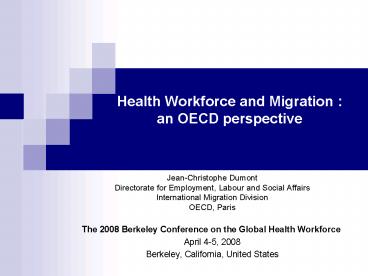Health Workforce and Migration : an OECD perspective - PowerPoint PPT Presentation
1 / 9
Title:
Health Workforce and Migration : an OECD perspective
Description:
Jean-Christophe Dumont. Directorate for Employment, Labour and Social Affairs ... Rising concerns about health worker shortages in many OECD countries ... – PowerPoint PPT presentation
Number of Views:65
Avg rating:3.0/5.0
Title: Health Workforce and Migration : an OECD perspective
1
Health Workforce and Migration an OECD
perspective
- Jean-Christophe Dumont
- Directorate for Employment, Labour and Social
Affairs - International Migration Division
- OECD, Paris
- The 2008 Berkeley Conference on the Global Health
Workforce - April 4-5, 2008
- Berkeley, California, United States
2
Background
- Rising concerns about health worker shortages in
many OECD countries - Population and health workforce ageing
- New technologies are generating increased demand
- Changing working patterns (feminisation, early
retirement ) - Potential competition amongst OECD countries to
attract and retain health professionals - Because of the increasing policy interest, good
data on stocks and on trends are essential.
3
Key results (1/7)
- There is a huge variety of situation across OECD
countries - but in many countries immigrants make an
important contribution to the health system - notably if one takes into account their role
in insuring the continuity of service.
Source International Migration Outlook , OECD
(2007)
4
Key results (2/7)
- The international migration of health workers is
characterised by multiple interactions between
OECD countries, including within the EU. - For both doctors and nurses the movements are
well depicted by a cascade type model. - The United States are the only net receiver with
all other OECD countries.
Intra-OECD migration of nurses a cascade-type
pattern Net
stocks, circa 2000
Source OECD population censuses and population
registers, circa 2000. Authors calculations
5
Key results (3/7)
Foreign-born doctors and nurses in the OECD by
main countries of origin, circa 2000
6
Key results (4/7)
- African and the Caribbean countries are
disproportionately affected - but the needs in human resources in developing
countries, as estimated by the WHO, largely
outstrip the numbers of immigrant health workers
in the OECD.
Sources OECD population censuses and population
registers for receiving countries and WHO data
on health workforce in origin countries.
7
Key results (5/7)
- The needs in human resources in developing
countries, as estimated by the WHO, largely
outstrip the numbers of immigrant health workers
in the OECD. - International migration is neither the main cause
nor would its reduction be the solution to the
worldwide health human resources crisis, even
though it exacerbates the acuteness of the
problems in some countries.
8
Key results (6/7)
- OECD countries have very few specific migration
programmes to date targeting health
professionals. Nevertheless, most of them have
special provisions to facilitate the migration of
the highly skilled in general, including health
professionals. - Bilateral agreements do not play an important
role so far. - Recognition of foreign qualifications remains an
important tool to insure high standards and
quality in healthcare delivery, but also serves
sometimes to control inflows of foreign-trained
workers.
9
Key results (7/7)
Inflow of health professionals in selected OECD
countries, 1995-2005
- Long-term trends over the past 25 years show that
the number and the percentage of foreign-trained
doctors has increased significantly in most OECD
countries. - Recent trends in migration, over the past 5
years, show radical upward shifts in several OECD
countries. - Policies matter (e.g. United Kingdom and
Australia). - Some key factors drive international migration of
health professionals































